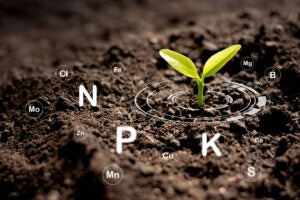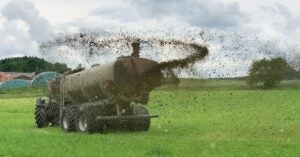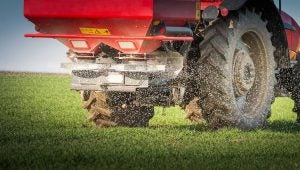One way to describe the state of agriculture today is variety, and fertilizer products are no exception. Two decisions that farmers face are: What type of fertilizer to apply and how much? Because of the knowledge and skill involved, there’s not always an easy and straight-forward answer to that question. So, let’s look at some of the types of fertilizer that farmers use:
What is fertilizer?
First off, it’s worth defining things and finding out: What is fertilizer? Fertilizer is something you add to soil to increase the fertility, increase growth rates, and increase crop yields. Fertilizer is composed of nutrients, which, just like people, plants need to grow. The major nutrients in fertilizer are nitrogen (N), phosphorus (P) and potassium (K). There can be other “micronutrients” in fertilizer such as calcium, magnesium, sulfur, zinc and more, but the most common are nitrogen, phosphorus, and potassium.
- Nitrogen helps plants form protein to grow. Nitrogen strengthens plants and is naturally found in the air, but plants can’t use it in this form, so they need to get it from another source. If it’s not readily available in the soil, farmers can apply fertilizer to supply nitrogen to plants.
- Phosphorus helps plants properly store and use energy during photosynthesis, and helps plants form strong root systems. Phosphorus comes from phosphate rock, which is mined and incorporated into fertilizers to make it accessible to plants.
- The last main nutrient is potassium, which acts like an immune booster for plants, helping them resist disease and tolerate different weather conditions. Potassium helps plants withstand some of the more extreme conditions they face. It’s found in potash, which is a type of salt.

Fertilizer generally contains these nutrients in some combination. Beyond this, there are still many different types of fertilizers, such as the origin and method of application. Fertilizers are incredibly important since they make healthy plants, can increase yields, and help farmers be more efficient and economically sustainable.
Types of fertilizers
One common type of fertilizer used today is commercial fertilizers, which are made with synthetic materials or are mined. If you’re buying fertilizer for your garden or lawn, there are special formulas for different types of plants, but commercial farming requires a little more science and attention.
Farmers generally only use what each field needs to increase soil health. They will also consider what crop is being produced and what nutrients that crop needs to grow and be healthy.
Organic fertilizers are derived from once-living plants or living animals. Manure is a commonly used organic fertilizer, and is a great way to reduce waste from animals. Manure provides organic matter and contributes to soil structure in addition to providing nutrients. In fact, 95 percent of poultry litter (bedding) is recycled to fertilize crops.

Compost is decomposed organic matter and is another great way to recycle food waste and other organic materials. Compost can also increase microbial activity in soil. Another natural fertilizer is cover crops that have been tilled back into the soil. This adds organic matter and nutrients to the soil.
Liquid fertilizer (like the name says) comes in liquid form and is often sprayed over the ground or injected directly into the ground. Farmers need to make sure they’re using the right amount to avoid runoff or environmental contamination. By following expert recommendations, farmers can see the benefits of fertilizer while protecting the environment. Liquid fertilizer allows for precise application and plants can quickly use the readily-available nutrients. There are also types of liquid fertilizer that can be sprayed onto the leaves of plants or placed in water (such as irrigation). This type of fertilizer is often common for home gardens.
Granular fertilizer is “dry” fertilizer and is often seen in small grains or granules. This type of fertilizer is applied by scattering it over the ground. Granular fertilizer can offer the slower release of nutrients, so plants are being fertilized over a longer period of time than when liquid fertilizer is used. Granular fertilizer can also be cheaper and easier to store. When farmers decide what types of fertilizer to use, they also need to consider logistics like price, storage, and ease of transportation.
Research shows that more modern “slow release” or “controlled release” fertilizer technology allows farmers to use fewer of them, where the plant receives the nutrients for a longer period of time.

Farmers often times use soil testing methods to know exactly what type of nutrients they need and when, and prefer to avoid overuse as often as possible as fertilizer costs can add up very quickly. Awards exist to recognize stewardship efforts — like the “4Rs,” which stands for the 1. Right source 2. Right rate 3. Right time and 4. Right place.
Many farmers use a combination of fertilizers. They take a lot into account when deciding what fertilizers to use and when. There are certainly a lot of options and farming is never a “one size fits all” type of business.
There are no fertilizers that are objectively better than others. Some are more effective quickly, while others are better over longer periods of time. As long as farmers continue to follow directions and ensure that there is no contamination of waterways, the use of fertilizer mostly just provides us with benefits. By giving us higher yields, healthier plants, more profits, and so much more, fertilizer is almost magic!
Michelle Miller, the Farm Babe, is a farmer, public speaker, and writer who has worked for years with row crops, beef cattle, and sheep. She believes education is key in bridging the gap between farmers and consumers.



